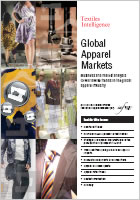Issue
5:
1st Quarter 2009

Product Overview
Buy this Report now
Buy this Issue now
Subscribe
Download brochure (PDF)
Download price list (PDF)
Price list download
| Please choose your preferred currency:
|
Request sample issue
View list of reports
in other issues
|
Multi Report Package |
We also offer a flexible subscription product,
the Multi Report Package,
which allows you to select your own choice of reports from our full range,
to suit your own budget.
Click here for full details.
|
|
 |
Trade and trade policy: the world's leading clothing exporters, 1st quarter 2009 |

31 pages,
published in Issue 5, 1st Quarter 2009
Report price:
Euro 600.00;
US$ 785.00
|
World clothing exports were worth US$345 bn in 2007, the latest year for which global data are available. Of this total, the world?s top 15 clothing exporters accounted for 86%, or US$298 bn. In terms of individual countries, China remained the largest exporter in 2007 with over US$115 bn worth of exports, representing 33% of the global total. The EU maintained its position as the second largest exporter, followed by Hong Kong, Turkey, Bangladesh, India, Vietnam, Indonesia, Mexico, the USA, Thailand, Pakistan, Morocco, Tunisia and Sri Lanka. Double digit growth in exports was enjoyed by the industries in China, the EU, Morocco, Tunisia, Turkey and Vietnam. However, there were sharp falls in exports from Mexico and the USA, and in domestic exports from Hong Kong. Moreover, it is likely that the global economic downturn will have negatively affected the prospects of these industries further in 2008. As a result, there is pressure on policy makers to create growth opportunities in 2009.
The EU has renewed its Generalised System of Preferences (GSP) scheme and added three new beneficiaries to the GSP+ arrangement?Armenia, Azerbaijan and Paraguay. However, Panama?s benefits have been rescinded because the country did not submit the required application before the EU?s deadline of October 31, 2008.
In 2009 China has attempted to reinvigorate foreign demand for its clothing products by increasing the tax rebate on exports. The move represented a reversal of a policy to restrain exports during 2007, which was an attempt to assuage potential concerns in the USA and the EU. Meanwhile, outward processing agreements (OPAs) with Hong Kong manufacturers have lost importance since the elimination of safeguard quotas on US imports from China at the end of 2008. But they are still being used by Hong Kong producers to keep costs down.
Elsewhere in Asia, Bangladeshi officials have unveiled a new strategy to increase clothing exports to US$25 bn by 2013. Vietnamese clothing exporters enjoyed a sense of relief as US customs officials lifted their Import Monitoring Program on imports from Vietnam?which allowed the Vietnamese industry to move a step closer to achieving its ambitious targets for export growth to 2010 and 2020. And Indonesia?s Economic Partnership Agreement (EPA) with Japan, which will encourage trade in clothing between the two countries, has taken effect.
In the Americas, Mexican officials have established ?transition tariffs? to comply with World Trade Organization (WTO) regulations regarding imports of clothing from China. And US representatives hope that a recent decision by the US government to file a WTO dispute settlement case against Chinese clothing subsidies will bring relief to the USA?s ailing manufacturing sector.
- Trade and trade policy: the world's leading clothing exporters
-
- Summary
- Introduction
- Major clothing trade flows
- China
- EU
- Hong Kong
- Turkey
- Bangladesh
- India
- Vietnam
- Indonesia
- Mexico
- USA
- Thailand
- Pakistan
- Morocco
- Tunisia
- Sri Lanka
|
 |
